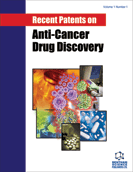Abstract
Background: Epidermal growth factor receptor and anaplastic lymphoma kinase play key roles in tumorigenesis and disease progression. Currently, targeted therapy is a better approach for cancer therapy compared with traditional chemotherapy. EGFR-based/ALK-based target therapies are key targets for drug development in cancer therapy.
Objective: The objective of this study was to show a recent trend in research and development of EGFR-based/ALK-based targets and to better understand the Intellectual Property surrounding EGFR-based and ALK-based targets.
Methods: EGFR-based and ALK-based targets were analyzed by comprehensive US patent analysis. US patents of EGFR-based/ALK-based targets were analyzed from September 2001 to September 2020.
Results: The results indicated that the key technologies and methods of EGFR-based/ALK-based targets were developed by large global pharmaceutical companies or American companies/universities. Small molecular inhibitors showed a higher percentage in the number of patents of EGFRbased targets. In addition, the present study also showed recent small molecular targeted drugs approved by FDA.
Conclusion: Global large pharmaceutical companies and American companies/universities have obvious advantages in the research and development of targeted drugs. EGFR-based target was still an attractive target for research and drug development in the past 10 years. Also, large global pharmaceutical companies prefer to complete key technology research and development by independent innovation instead of collaboration.
Keywords: EGFR, ALK, targeted drugs, patent analysis, epidermal growth factor receptor, anaplastic lymphoma kinase.
Recent Patents on Anti-Cancer Drug Discovery
Title:Recent Trend for EGFR-Based and ALK-Based Targets: A Patent Analysis
Volume: 16 Issue: 3
Author(s): Hai-Long Zhang* Yiqian Li
Affiliation:
- Central International Intellectual Property (Baotou) Co., Ltd., Baotou, Inner Mongolia 014030,China
Keywords: EGFR, ALK, targeted drugs, patent analysis, epidermal growth factor receptor, anaplastic lymphoma kinase.
Abstract:
Background: Epidermal growth factor receptor and anaplastic lymphoma kinase play key roles in tumorigenesis and disease progression. Currently, targeted therapy is a better approach for cancer therapy compared with traditional chemotherapy. EGFR-based/ALK-based target therapies are key targets for drug development in cancer therapy.
Objective: The objective of this study was to show a recent trend in research and development of EGFR-based/ALK-based targets and to better understand the Intellectual Property surrounding EGFR-based and ALK-based targets.
Methods: EGFR-based and ALK-based targets were analyzed by comprehensive US patent analysis. US patents of EGFR-based/ALK-based targets were analyzed from September 2001 to September 2020.
Results: The results indicated that the key technologies and methods of EGFR-based/ALK-based targets were developed by large global pharmaceutical companies or American companies/universities. Small molecular inhibitors showed a higher percentage in the number of patents of EGFRbased targets. In addition, the present study also showed recent small molecular targeted drugs approved by FDA.
Conclusion: Global large pharmaceutical companies and American companies/universities have obvious advantages in the research and development of targeted drugs. EGFR-based target was still an attractive target for research and drug development in the past 10 years. Also, large global pharmaceutical companies prefer to complete key technology research and development by independent innovation instead of collaboration.
Export Options
About this article
Cite this article as:
Zhang Hai-Long*, Li Yiqian , Recent Trend for EGFR-Based and ALK-Based Targets: A Patent Analysis, Recent Patents on Anti-Cancer Drug Discovery 2021; 16 (3) . https://dx.doi.org/10.2174/1574892816666210413151906
| DOI https://dx.doi.org/10.2174/1574892816666210413151906 |
Print ISSN 1574-8928 |
| Publisher Name Bentham Science Publisher |
Online ISSN 2212-3970 |
Related Books
 23
23 2
2
- Author Guidelines
- Bentham Author Support Services (BASS)
- Graphical Abstracts
- Fabricating and Stating False Information
- Research Misconduct
- Post Publication Discussions and Corrections
- Publishing Ethics and Rectitude
- Increase Visibility of Your Article
- Archiving Policies
- Peer Review Workflow
- Order Your Article Before Print
- Promote Your Article
- Manuscript Transfer Facility
- Editorial Policies
- Allegations from Whistleblowers
Related Articles
-
RNA Splicing Manipulation: Strategies to Modify Gene Expression for a Variety of Therapeutic Outcomes
Current Gene Therapy Iron Chelators: Development of Novel Compounds with High and Selective Anti-Tumour Activity
Current Drug Delivery State of Research Tracks and Property Protection of Photodynamic Sensitizers and Delivery Methodologies
Recent Patents on Chemical Engineering TRPV1: On the Road to Pain Relief
Current Molecular Pharmacology Synthesis and Inhibitory Effects of Some Novel 1,3-diarylprop-2-en-1-one Analogues in Foxp3 Expression: A Novel Class of Anti-cancer Candidates
Medicinal Chemistry Emerging Drugs and Indications for Cardio-Metabolic Disorders in People with Severe Mental Illness
Current Pharmaceutical Design An Overview of Nanoformulated Nutraceuticals and their Therapeutic Approaches
Current Nutrition & Food Science The Adenine Nucleotide Translocator: A New Potential Chemotherapeutic Target
Current Drug Targets The Urokinase Plasminogen Activator System: A Target for Anti-Cancer Therapy
Current Cancer Drug Targets Targeting Epigenome As An Innovative Pharmacological Strategy For Castration-resistant Prostate Cancer
Clinical Cancer Drugs Proteomics Using Mammospheres as a Model System to Identify Proteins Deregulated in Breast Cancer Stem Cells
Current Molecular Medicine Gold and Silver Nanoparticles for Applications in Theranostics
Current Topics in Medicinal Chemistry Physcion and Physcion 8-O-β-D-glucopyranoside: Natural Anthraquinones with Potential Anticancer Activities
Current Drug Targets Alzheimer’s Disease and Environmental Exposure to Lead: The Epidemiologic Evidence and Potential Role of Epigenetics
Current Alzheimer Research Diagnosis and Management of Endocrine Hypertension in Children and Adolescents
Current Pharmaceutical Design MicroRNAs in Cancer Stem Cells: New Regulators of Stemness
Current Pharmaceutical Design Heat Shock Proteins (HSPs): A Novel Target for Cancer Metastasis Prevention
Current Drug Targets Peroxisome Proliferator Activated Receptor α Ligands as Anticancer Drugs Targeting Mitochondrial Metabolism
Current Pharmaceutical Biotechnology Urine Cells-derived iPSCs: An Upcoming Frontier in Regenerative Medicine
Current Medicinal Chemistry Genitourinary Tract Tumors in Children: An Update
Current Pediatric Reviews


























